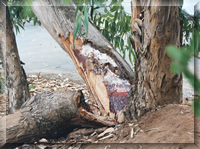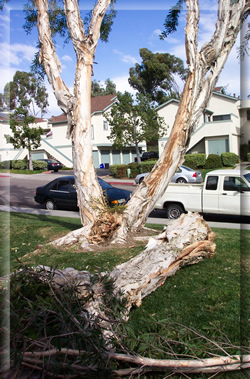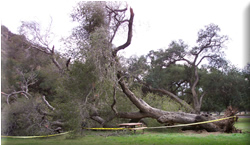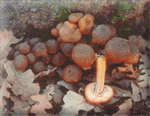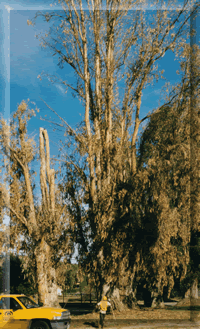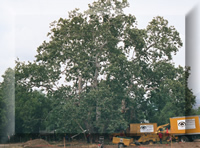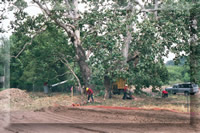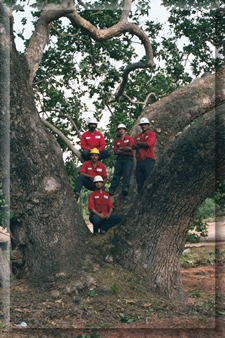| |
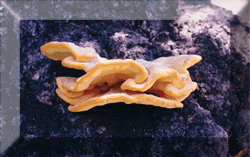 HOME
HOME |
 QUALIFICATIONS
QUALIFICATIONS |
 RATES
RATES |
 AIR-SPADE
AIR-SPADE |

EVALUATION |

TREE APPRAISAL |

EXPERT WITNESS |
| |
| |
|
TREE EVALUATION
&
Tree Risk Assessment
| 1 |
Tree evaluations can give some forewarning
to structural problems or weaknesses that may result in tree failure (limbs or
leaders breaking) or complete tree failure (the tree falling over). A Tree
Risk Assessment can be a valuable part of an evaluation or the only
reason for the evaluation. |
| |
The split
leaders (left) were
the result of weak attachments because
of acute branch
angles and included bark
of co-dominante stems.
Fortunately the failure
only resulted in
minor property damage and no injuries.
The
result of this same defect can be seen
on the multi-trunk melaleuca to the
right.
This failure landed on a car. Multi-trunks
can be attractive
but are very weak. |
|
|
|
An evaluation of the live oak (left) determined
that there was extensive root decay. The crown had severe dieback and, duringthe
winter, the area within the dripline had a large number of honey mushrooms (right).
These honey mushrooms are the fruiting body of oak root fungus, Armillaria
mellea. The tree was not removed and fell over. Fortunately, there were no
injuries. | |
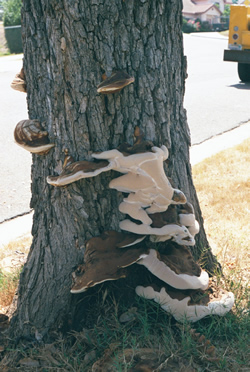
Above are the basidiocarps
of the
white rot,
Ganoderma applanatum. |
CONKS & MUSHROOMS
-- signs
of decay -- By the
time conks appear,
the fungus has been decomposing
the wood for years. Breaking
off the conk or removing
the mushrooms does nothing to
stop the fungus.
The majority of the fungus, the mycelium, is in the
wood or cambium. Decay
detection may help determine
the extent of internal decay. |
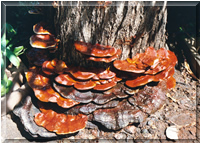
The conks of
Ganoderma lucidum,
a white rot (above) are a sign of
decay
inside the base of this trunk. This fungus kills the cambium as well as rotting
the wood. This will lead to complete tree failure.
|
TREE
RISK ASSESSMENT
Look for a TRAQ (Tree Risk Assessment Qualification) certified person.
There are 3
levels of risk assessment defined by the International of Society of Arboriculture's
Tree Risk Assessment: - Level
1: Limited visual
- Level 2: Basic
- Level
3: Advanced
|
|
LEVEL
1: Limited Visual Assessment This is a limited walk-by, drive-by
or fly-over, which does not necessarily entail a complete walk around a tree.
This usually only includes the specific tree or trees that are being considered
for the purpose of a proposal for work or risk assessment. This generally focuses
on obvious defects, imminent or probable likelihood of failures and may not even
classify as true "risk assessment" if there is no evaluation or analysis
of the individual tree(s). There are generally no tools used at this level. This
is the fastest and least thorough assessment. LEVEL
2: Basic Assessment
This is the standard or
basic assessment in response to a client's request for tree risk assessment.
This generally entails more time on the tree to include a walk around inspection.
Simple tools such as probes, measuring devices, binoculars, mallet or magnifying
glass or scope may be used. This typically does not include an aerial inspection
(other than, possibly, a ground level inspection with binoculars) or below ground
inspection. A Level 2 assessment is usually necessary for determining the need
and scope of a Level 3 assessment. LEVEL
3: Advanced Assessment This is the most detailed
and time consuming level of assessment. This level usually requires specialized
equipment, data collection and analysis, as well as a higher level of expertise
from the assessor. Some examples of specialized examples of equipment are the
Air Spade
or the Resistograph.
This may also involve sending samples to labs for analysis. The assessor should
determine which methods are appropriate and/or the least invasive and discuss
this with the client. As noted above, a Level 2 assessment is usually required
to determine the need and scope of a Level 3, which will usually take place at
a later time due to time requirements determined during a Level 2. All
assessments, evaluations and technologies have limitations. Any evaluation of
an individual tree is not an accurate measure, but a qualified estimation. Arborists
cannot detect every condition that could possibly lead to the structural failure
of a tree. Trees are living organisms that fail in ways we do not fully understand.
Conditions are often hidden within trees and below ground. Arborists cannot guarantee
that a tree will be healthy or safe under all circumstances, or for a specified
period of time. Likewise, remedial treatments, like any medicine, cannot be guaranteed. Trees
can be managed, but they cannot be controlled. To live near trees is to accept
some degree of risk. The only way to eliminate all risk associated with trees
is to eliminate all trees. |
| 2 |
An evaluation can also spot conditions causing
tree stress.
Stressed trees are more susceptible to deseases and insect
attacks than are healthy trees. |
| |
The blue gum eucalyptus (left), Eucalyptus
globulus, were killed by the eucalyptus
long-horned beetle. The beetle is a secondary infestation and (in the
blue gum's natural habitat) a natural weeding agent of stressed and unhealthy
trees. The trees were stressed after years of drought and no supplemental irrigation.
The beetles are able to enter the cambium area of the tree where the larvae destroy
the tree's ability to transport water resulting in death. |
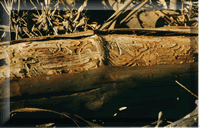
Above
are the channels the feeding
larvae create under the bark.
This is what
is left of the tree's
vascular bundle. There
are different bark beetles
for different genus of trees,
but the result
is the same and
the primary cause is stress. |
| 3 |
An evaluation is also invaluable
in protecting the health
and future of specimen trees and recommending
proper care & maintenance. |
| |
This California sycamore, Plantanus
racemosa, had an evaluation prior to starting construction of a sub-division.
As a result of the evaluation, competing trees within the dripline were removed.
The area within the dripline was mulched and a construction fence was placed approximately
five feet outside the dripline to protect the root zone during construction. This
tree has since been successfully registered as the National co-champion for the
largest California sycamore. It is located in Poway, California. |
|
Call 619-443-1770 for an evaluation before it's too
late! |
![]() "When experience is important!"
"When experience is important!"
![]()

